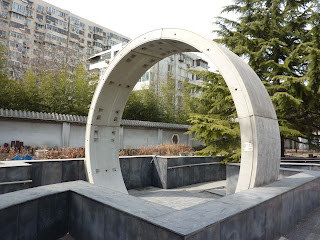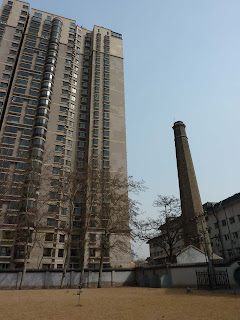Having exhausted the major tourist sites in my host city, I have turned to the deeper pages of my Insider's Guide to Beijing in search of interesting places off the beaten path. I've got a short list of places I'd like to hit before I leave, and now that I have a better idea of transportation here, I can go to 1 or 2 places in a weekend afternoon and still have plenty of time for sleeping in and relaxing!
After lunch, I headed off to the Beijing Tap Water Museum, which intrigued me, I wanted to go so I could say I had been! They are very proud of their achievements in China, and it seems like signs at touristic places are always touting that they were the first to do this or that. I was curious what they could be touting at the tap water museum since you still can't drink the tap water here for fear of bacteria and heavy metals! The museum started off with a courtyard that was the site of the old water collection and pumping facility: check out this ginormous pipe! It brought water to Beijing from somewhere far away.
There were several ground wells that were built in the 70s when the authorities realized they didn't have enough water for the swelling population, including one adorned with a water goddess of some kind, bizarrely kept behind a locked door. I took this picture through the crack in the door, that's why its so skinny, but its a shame that its kept out of sight!
There was also an old watchtower for the premises, although the signs didn't say what exactly they were watching for. It looks a little sad now though, as the view from the top has been truncated by modernity:
Inside the museum building itself was a little disappointing as the English signage didn't cross the threshold...but there were still some interesting exhibits. I translated one sign to learn that there is a water network node for checking pressure close to my apartment - good to know! There were many modern pictures of people in official-looking white coats peering at test tubes, and several of men in suits shaking hands at the sites of new water towers. There was also a Handbook for Water Security, something I would never have thought of needing for the Olympics:
And the oh-so-necessary 'chop' or official stamp - in fact, apparently many of them were needed for the water company. If every company and institution has this many stamps, no wonder its an effort to get anything approved here, it must take them a while to figure out which stamp to use!
I started this weekend with lunch with some people at Wangfujing, previously famous for its night market of 'pretty much anything on a stick' including slugs and scorpions that are still wriggling, but more recently well known for its attempted anti-government 'protest' several weeks ago. There were rumors that the government erected a fake construction wall in front of the McDonalds, site of the supposed demonstration, and I saw it on Saturday, certainly taking up a lot of potential protest room in the plaza.
After lunch, I headed off to the Beijing Tap Water Museum, which intrigued me, I wanted to go so I could say I had been! They are very proud of their achievements in China, and it seems like signs at touristic places are always touting that they were the first to do this or that. I was curious what they could be touting at the tap water museum since you still can't drink the tap water here for fear of bacteria and heavy metals! The museum started off with a courtyard that was the site of the old water collection and pumping facility: check out this ginormous pipe! It brought water to Beijing from somewhere far away.
There were several ground wells that were built in the 70s when the authorities realized they didn't have enough water for the swelling population, including one adorned with a water goddess of some kind, bizarrely kept behind a locked door. I took this picture through the crack in the door, that's why its so skinny, but its a shame that its kept out of sight!
The signs around the campus were all very inspirational - its amazing how even a defunct water processing plant can be made to sound grand!
There was also an old watchtower for the premises, although the signs didn't say what exactly they were watching for. It looks a little sad now though, as the view from the top has been truncated by modernity:
Inside the museum building itself was a little disappointing as the English signage didn't cross the threshold...but there were still some interesting exhibits. I translated one sign to learn that there is a water network node for checking pressure close to my apartment - good to know! There were many modern pictures of people in official-looking white coats peering at test tubes, and several of men in suits shaking hands at the sites of new water towers. There was also a Handbook for Water Security, something I would never have thought of needing for the Olympics:
And the oh-so-necessary 'chop' or official stamp - in fact, apparently many of them were needed for the water company. If every company and institution has this many stamps, no wonder its an effort to get anything approved here, it must take them a while to figure out which stamp to use!
As I was relaxing after my excursion with a coffee, it hit me just how citified I have become in Beijing, because it took a while before this view became unnatural looking:









No comments:
Post a Comment